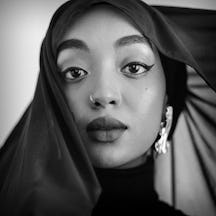Proudly dark-skinned, writer Ngunan Adamu couldn’t understand why some people choose to lighten their skin. But uncovering the medical perspective on bleaching opened her mind to its legitimate uses.
The case for safe skin bleaching
Words by Ngunan Adamuphotography by Amaal Saidaverage reading time 6 minutes
- Serial

Like many members of the Black community – and the media, too – I had a negative view of skin bleaching. I never quite understood why anyone would want to be lighter if they were born naturally dark-skinned. Growing up in Liverpool, I was the target of some hurtful comments from other young Black women and family members, who would say how much more beautiful I could be if I was lighter.
Although being fair is a big thing in African and Caribbean communities, I found that people who obviously looked like they bleached their skin were made fun of or ridiculed. Within the Nigerian community we use the word ‘knocked’ when the bleaching has somewhat stopped working or the skin is too damaged and has gone darker than its original shade. We also have a couple of sayings: ‘Fanta face, Coca-Cola body’ and ‘face is in Europe and body is in Africa’. This is when women can only afford to bleach their face and not the rest of their body.
Although I couldn’t understand why anyone would want to damage their skin like this, through my research I found that the NHS uses skin-lightening products in medical situations. I got in touch with Dr Faisal Ali, a consultant dermatologist working in Macclesfield and London.
I wanted to find out which medical conditions you would need skin-lightening treatment for. I already knew it was used for ‘pregnancy mask’, also known as chloasma, as a friend of mine was prescribed skin-bleaching cream for this condition by her doctor, after suffering for years, having developed it during her first pregnancy back in 1994.
Dark patches and how to fade them
Dr Ali told me that many people in the African and Caribbean communities resort to skin bleaching for a variety of reasons. Different racial groups have varying tones of skin, which is a result of their underlying genes. There are also multiple medical skin conditions, and Dr Ali most commonly sees melasma and post-inflammatory hyperpigmentation.
People with melasma develop brown patches, usually on the face. It’s typically seen in older women, although men and younger women can be affected. It is common and in some cases can be made worse by pregnancy or hormonal contraceptive pills.
Post-inflammatory hyperpigmentation is a darkening of the skin following trauma or inflammation. Trauma could be a burn, but could also include procedures such as chemical peels or laser treatments. Inflammation of the skin can also be caused by conditions like acne, eczema and psoriasis. People who have naturally darker skin tones have an increased likelihood of developing post-inflammatory hyperpigmentation.
More: Using storytelling to form a sense of belonging as a refugee

Marwa, 23: “I’ve stopped using it now because I don’t like how it makes my skin feel. It was easy to start and that’s because I’ve grown up around aunts and cousins who made it seem like it wasn’t a big deal.”
Dr Ali also mentioned that there are some steps that everyone can easily take to protect themselves against developing darker patches of skin. Firstly, make sure you use a broad-spectrum sunblock that should protect against ultraviolet-B (SPF 30 or above), ultraviolet-A (indicated by the star rating on the bottle) and, ideally, visible light as well. Regular sun protection prevents the melanocytes (pigment cells) in the skin from activating and reduces abnormal hyperpigmentation.
If there is a trigger for the hyperpigmentation, make sure you are no longer exposed to that trigger. For example, if you have developed post-inflammatory hyperpigmentation following laser treatment, stop the laser treatment. If you have developed patches of post-inflammatory hyperpigmentation due to acne, make sure the acne is fully treated by a dermatologist to prevent further patches developing.
The perils of dangerous ingredients
One of the problems with some of the skin-lightening products you can buy is the dangerous amount of hydroquinone in them, so I wanted to know what ingredients are in the skin-bleaching creams used by the NHS or private dermatologists.
It’s illegal to sell products containing hydroquinone over the counter or online in the UK, but Dr Ali revealed that it’s one of the commonest ingredients contained in prescription creams used to lighten the skin. Hydroquinone and related compounds can be highly effective, but have to be used in addition to a regular sunblock and only under the supervision of a specialist.
The need for a lighter complexion seems to outweigh the need for a healthy skin.
If used for long periods of time or in high concentrations, hydroquinone can cause exogenous ochronosis, which appears as a blue-black tone, commonly around the sides of the eyes. It is extremely difficult to treat and can be permanent. Another serious side effect from long-term hydroquinone use is blistering, infection and scarring.
Treatment tips and cautionary advice
Dr Ali did point out that other skin-lightening treatments are available – such as lasers, chemical peels, injections and oral medication – but which one to use depends on the underlying condition. In all cases, it is important that the treatment is given by an appropriately qualified and experienced professional, who can explain the risks and benefits.
He has a few tips for anyone thinking of skin-lightening treatment. Before treating pigmentation, it is important to have a diagnosis from a specialist, and this may involve skin analysis or a biopsy. Any treatment should be tailored to you and your particular skin condition. And if you are thinking of using skin bleaching for ‘cosmetic’ reasons, then it might be beneficial to speak to a psychologist about any underlying issues that you are dealing with before taking the skin-lightening route.
Skin bleaching is not something that should be taken lightly, especially when you look at the chemicals used. If someone threatened to throw acid in your face, you would most likely call the police, so why are women knowingly using dangerous products? The need for a lighter complexion seems to outweigh the need for a healthy skin.
If you have any of the conditions I’ve mentioned above, then you should seek the appropriate treatment. If you’ve found a bleaching product on the high street, get advice before applying it: it could interact badly with other skin products or your medication, can make you more sensitive to sunlight so that you burn more easily, and could be dangerous if you have certain medical conditions, such as asthma or kidney disease. It is better to be safe than sorry.
How Dr Ali changed my opinion
Talking to Dr Ali has opened my mind to skin bleaching from a medical perspective. My friend, who is a white woman, had no choice of treatment, as her pregnancy mask was across her forehead and had been there for years; finally, 22 years after it appeared, she was prescribed skin-bleaching cream by her doctor, but it was only for short-term use. Knowing this made me feel more sympathetic towards people who use skin-bleaching products, but also opened my eyes to the type of people who use them.
Manufacturers often market their products as cosmetic treatments, but I’ve come to realise that skin bleaching should only be a short-term solution for medical use.
About the contributors
Ngunan Adamu
Ngunan Adamu is a radio presenter and producer for BBC Radio Merseyside, CEO and founder of iWoman Academy/Media, and an international multimedia trainer for the BBC.
Amaal Said
Amaal Said is a Danish-born Somali photographer and poet, based in London. Her photographs have been featured in Vogue, the Guardian and the New Yorker. In 2017, she was exhibited in Los Angeles, and in 2018 her photography was featured in the fourth volume of African Lens and exhibited in Accra, Ghana.

